A YEAR OF ECSTATIC MOMENTS
Last year, as ever, I missed what I am told was some of the best theater that went up in Southern California. I don’t know what’s Best or Most. I saw shows that knocked me out and shows that didn’t. It is always a profound inspiration to see people do outstanding work in a compromised frame. Joel Daavid designed and built some amazing sets last year; Leon Russom gave a pair of absolutely arresting performances. I could go on. But when pretty much an entire production works, heaven opens.
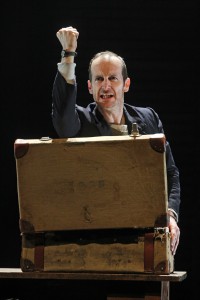 Last year started for me with Denis O’Hare’s An Iliad at the Broad Stage, which made an extraordinarily strong case for the one-man show as high art – and for the value of collaboration in the creation of solo work. His adaptation of Homer, co-written with his understated director Lisa Peterson, exploits and extends the source material in a permanent way. But it was O’Hare’s performance, as a weary poet condemned to keep reciting his lesson of human frailty through the millennia in a bitter quest to teach us about ourselves, that gave me the supernatural heebie-jeebies. I believed that O’Hare was, in fact, possessed by a spirit as old as storytelling. I believe it now.
Last year started for me with Denis O’Hare’s An Iliad at the Broad Stage, which made an extraordinarily strong case for the one-man show as high art – and for the value of collaboration in the creation of solo work. His adaptation of Homer, co-written with his understated director Lisa Peterson, exploits and extends the source material in a permanent way. But it was O’Hare’s performance, as a weary poet condemned to keep reciting his lesson of human frailty through the millennia in a bitter quest to teach us about ourselves, that gave me the supernatural heebie-jeebies. I believed that O’Hare was, in fact, possessed by a spirit as old as storytelling. I believe it now.
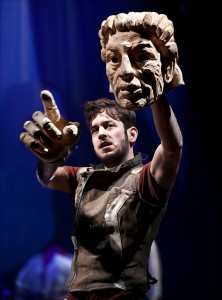 Also at the Broad was The Bristol Old Vic/Handspring Puppet Company’s tour of A Midsummer Night’s Dream. A strong company of actors and a remarkable unity of design aesthetics, under the direction of Tom Morris, made for one of my only altogether enjoyable experiences of this play. But Puck – Puck, the dangerous mystery of elemental power – was realized by three actors and some old gardening equipment (under Handspring designers Adrian Kohler and Basil Jones), and I don’t know whether any one actor will ever excite me so in that role.
Also at the Broad was The Bristol Old Vic/Handspring Puppet Company’s tour of A Midsummer Night’s Dream. A strong company of actors and a remarkable unity of design aesthetics, under the direction of Tom Morris, made for one of my only altogether enjoyable experiences of this play. But Puck – Puck, the dangerous mystery of elemental power – was realized by three actors and some old gardening equipment (under Handspring designers Adrian Kohler and Basil Jones), and I don’t know whether any one actor will ever excite me so in that role.
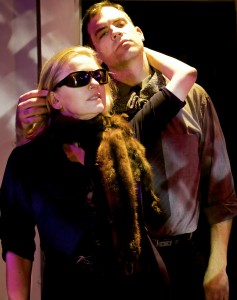 She has since stepped down as EST/LA’s artistic director, but Gates McFadden, who was on my very short list of reasons to go to Glendale, directed the scalpel-sharp production of The Ugly One, Marius von Mayenburg’s 2007 comedy of renewal and capitulation in the politics of identity. Her thrilling, kinetic integration of both Hana Kim’s set and multimedia design, and Joseph “Sloe” Slawinski’s soundscape, would have been the showpiece of the whole production, if not for her direction of actors. Robert Joy, Tony Pasqualini and Pete Larney gave supercharged performances; Eve Gordon burned rubber all over that little room.
She has since stepped down as EST/LA’s artistic director, but Gates McFadden, who was on my very short list of reasons to go to Glendale, directed the scalpel-sharp production of The Ugly One, Marius von Mayenburg’s 2007 comedy of renewal and capitulation in the politics of identity. Her thrilling, kinetic integration of both Hana Kim’s set and multimedia design, and Joseph “Sloe” Slawinski’s soundscape, would have been the showpiece of the whole production, if not for her direction of actors. Robert Joy, Tony Pasqualini and Pete Larney gave supercharged performances; Eve Gordon burned rubber all over that little room.
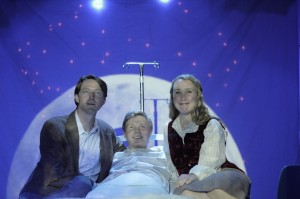 David Saar’s 1997 child-with-AIDS play The Yellow Boat also went up in April, in Joe Calarco’s painstaking hands, via Coeurage Theatre Company. This was a case of good writing subverted into excellence by a cast and director who just could not take a wrong step, proving that money is never what makes theater work. Ships sailed, colors danced, fantasy walked unaffectedly into and out of real life, all on a tiny stage, to greater effect than in shows with fifty times the Coeurage budget. Afterward, the cast had to come out and comfort an audience that sat, weak and helpless, needing a hug. Which it got. Hugs are important in overcoming trauma.
David Saar’s 1997 child-with-AIDS play The Yellow Boat also went up in April, in Joe Calarco’s painstaking hands, via Coeurage Theatre Company. This was a case of good writing subverted into excellence by a cast and director who just could not take a wrong step, proving that money is never what makes theater work. Ships sailed, colors danced, fantasy walked unaffectedly into and out of real life, all on a tiny stage, to greater effect than in shows with fifty times the Coeurage budget. Afterward, the cast had to come out and comfort an audience that sat, weak and helpless, needing a hug. Which it got. Hugs are important in overcoming trauma.
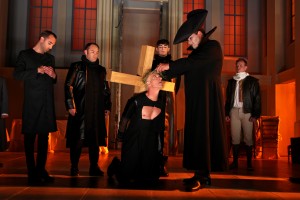 A little later, Dominique Serrand’s ferocious staging of Moliere’s Tartuffe, in a Berkeley Rep/Shakespeare Theatre Company production using David Ball’s sleek 1998 adaptation, came to South Coast Rep. Serrand co-designed the set with Thomas Buderwitz, and as lighted by Marcus Dilliard and costumed by Sonya Berlovitz, this world emerged as one congruent force. The reality he created was not so much heightened as levitating. Stephen Epp’s rapacious Tartuffe couldn’t be terrifying unless Cate Scott Campbell and Lenne Klingaman convincingly portrayed intelligent, adorable women worth barring the door to protect. Among many fine supporting performances, Michael Manuel elevated himself by dual roles as a crotchety old lady in a wheelchair and a towering embodiment of retribution. But it’s what Serrand did with this story, how he arranged bodies, furniture, and emotion to express the elements of morality, that made it all matter.
A little later, Dominique Serrand’s ferocious staging of Moliere’s Tartuffe, in a Berkeley Rep/Shakespeare Theatre Company production using David Ball’s sleek 1998 adaptation, came to South Coast Rep. Serrand co-designed the set with Thomas Buderwitz, and as lighted by Marcus Dilliard and costumed by Sonya Berlovitz, this world emerged as one congruent force. The reality he created was not so much heightened as levitating. Stephen Epp’s rapacious Tartuffe couldn’t be terrifying unless Cate Scott Campbell and Lenne Klingaman convincingly portrayed intelligent, adorable women worth barring the door to protect. Among many fine supporting performances, Michael Manuel elevated himself by dual roles as a crotchety old lady in a wheelchair and a towering embodiment of retribution. But it’s what Serrand did with this story, how he arranged bodies, furniture, and emotion to express the elements of morality, that made it all matter.
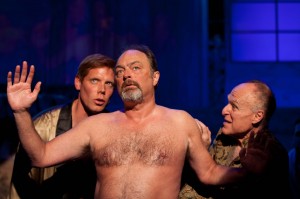 Enda Walsh’s 2010 meanwhile-during-the-Odyssey play about not reaching your potential but still managing to be better than you think you’d like to be, Penelope, got a rip-snorter at Rogue Machine. John Perrin Flynn and five ridiculously well-cast actors (Ron Bottitta, Richard Fancy, Brian Letscher, Scott Sheldon, Holly Fulger) plumbed all available profundity in this word-drunk story of men on the eve of destruction by mythological imperative. And Stephanie Kerley Schwartz designed a set, brilliantly realized by David Mauer, that convinced me I was at the bottom of a swimming pool in an ancient Ithaca of the modern Irish mind, by way of Pico and La Brea. Pure delight.
Enda Walsh’s 2010 meanwhile-during-the-Odyssey play about not reaching your potential but still managing to be better than you think you’d like to be, Penelope, got a rip-snorter at Rogue Machine. John Perrin Flynn and five ridiculously well-cast actors (Ron Bottitta, Richard Fancy, Brian Letscher, Scott Sheldon, Holly Fulger) plumbed all available profundity in this word-drunk story of men on the eve of destruction by mythological imperative. And Stephanie Kerley Schwartz designed a set, brilliantly realized by David Mauer, that convinced me I was at the bottom of a swimming pool in an ancient Ithaca of the modern Irish mind, by way of Pico and La Brea. Pure delight.
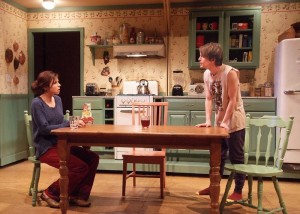 Aaron Posner’s hot, smart new adaptation of Chekhov’s The Seagull, Stupid Fucking Bird, went up in a Boston Court co-production with Circle X, and confirmed that reverence is the least of a custodian’s concerns. Updated isn’t a dirty word in this show about theater people in love, especially as directed by a laser-focused Michael Michetti and performed by a flawless ensemble. Will Bradley’s Conrad was so recognizable a type that I kept squinting to make sure he wasn’t one of my own pretentious friends. Theater is becoming such a closed system that if the navel gazing stays this brutal and crystalline, I may lose my prejudice against art about art.
Aaron Posner’s hot, smart new adaptation of Chekhov’s The Seagull, Stupid Fucking Bird, went up in a Boston Court co-production with Circle X, and confirmed that reverence is the least of a custodian’s concerns. Updated isn’t a dirty word in this show about theater people in love, especially as directed by a laser-focused Michael Michetti and performed by a flawless ensemble. Will Bradley’s Conrad was so recognizable a type that I kept squinting to make sure he wasn’t one of my own pretentious friends. Theater is becoming such a closed system that if the navel gazing stays this brutal and crystalline, I may lose my prejudice against art about art.
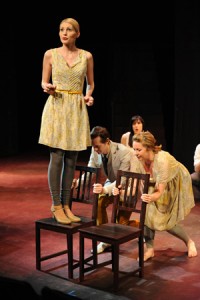 Impro Theatre held a fundraiser at the NoHo Arts Center, which I did not review, but which impressed me as much as anything I have seen from this consistently astonishing troupe. Their improvisation of a musical in the style of Stephen Sondheim made me start to appreciate Sondheim musicals, a remarkable development. The 90-minute one-off The Grass Is Always Greener Over There, directed by Dan O’Connor and Michele Spears, with musical direction/piano accompaniment by Peter Smith, was entirely made up in front of me by seven primates. Really. Several bright, pointed songs, with Sondheim’s signature patter and overlapping duet, invented and sung and played in their entirety. They
Impro Theatre held a fundraiser at the NoHo Arts Center, which I did not review, but which impressed me as much as anything I have seen from this consistently astonishing troupe. Their improvisation of a musical in the style of Stephen Sondheim made me start to appreciate Sondheim musicals, a remarkable development. The 90-minute one-off The Grass Is Always Greener Over There, directed by Dan O’Connor and Michele Spears, with musical direction/piano accompaniment by Peter Smith, was entirely made up in front of me by seven primates. Really. Several bright, pointed songs, with Sondheim’s signature patter and overlapping duet, invented and sung and played in their entirety. They 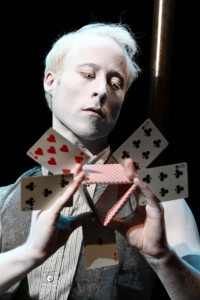 propelled a story of suburban wife-swapping, rocket science, and outlaw space exploration in the 1960s, rife with theme and motif and spot-on acting and writing choices and will somebody book these guys a national tour already?
propelled a story of suburban wife-swapping, rocket science, and outlaw space exploration in the 1960s, rife with theme and motif and spot-on acting and writing choices and will somebody book these guys a national tour already?
The Tempest brought me back to South Coast Rep. Aaron Posner and magician Teller’s new adaptation of Shakespeare was the draw for me; that, and their co-direction of this show produced by ART in Boston and the Smith Center for the Performing Arts in Las Vegas. The whole show was a lot of fun, streamlined to turn a famously clunky play structure into a music-buoyed, sleight-of-hand stage spectacle. But it was also the first Tempest to make me cry multiple times. Nate Dendy’s ethereal and enormously present Ariel subtly stole a patron’s watch as the audience got seated, and his work only got more impressive from there.
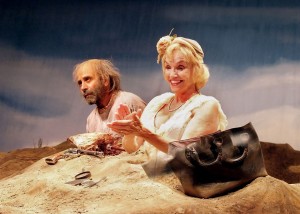 Back at Boston Court, Samuel Beckett’s 1961 Happy Days received a lovely production directed by Andrei Belgrader with comic languor that underscored the life-and-death gravity of its absurdist metaphor: a vivacious woman literally buried, and further handicapped (or helpmeeted) by a cretinous husband. As performed by Brooke Adams and husband Tony Shalhoub, on Takeshi Kata’s wonderful set (Beckett said the stage should bring to mind a third-rate touring company), this rigidly protected text transcended the strictures of the author’s estate to feel free and fresh.
Back at Boston Court, Samuel Beckett’s 1961 Happy Days received a lovely production directed by Andrei Belgrader with comic languor that underscored the life-and-death gravity of its absurdist metaphor: a vivacious woman literally buried, and further handicapped (or helpmeeted) by a cretinous husband. As performed by Brooke Adams and husband Tony Shalhoub, on Takeshi Kata’s wonderful set (Beckett said the stage should bring to mind a third-rate touring company), this rigidly protected text transcended the strictures of the author’s estate to feel free and fresh.
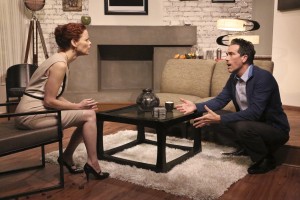 The decline of the year showcased one of its theatrical highlights: Edward Albee’s 2002 The Goat or, Who Is Sylvia? at the L.A. Gay and Lesbian Center, in a hilariously tragic Jon Imparato production directed precisely to the edge of sanity by Ken Sawyer. The play, about a lucky man who throws everything away when he falls in love with a farm animal, is modern canon. Supporting actors Matt Kirkwood and Spencer Morrissey were very good. But they, Matt Richter’s quietly exciting lights, Robert Selander’s sexy set, Paula Higgins’ generous costumes, and all of Sawyer’s exquisite direction, was sent by God to assist Ann Noble and Paul Witten in relaying, with astounding, tooth-grinding perfection, some of the best husband-and-wife dialogue Albee has ever written.
The decline of the year showcased one of its theatrical highlights: Edward Albee’s 2002 The Goat or, Who Is Sylvia? at the L.A. Gay and Lesbian Center, in a hilariously tragic Jon Imparato production directed precisely to the edge of sanity by Ken Sawyer. The play, about a lucky man who throws everything away when he falls in love with a farm animal, is modern canon. Supporting actors Matt Kirkwood and Spencer Morrissey were very good. But they, Matt Richter’s quietly exciting lights, Robert Selander’s sexy set, Paula Higgins’ generous costumes, and all of Sawyer’s exquisite direction, was sent by God to assist Ann Noble and Paul Witten in relaying, with astounding, tooth-grinding perfection, some of the best husband-and-wife dialogue Albee has ever written.
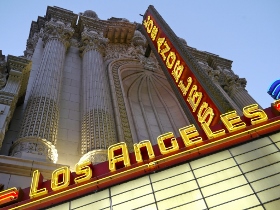

{ 2 comments… read them below or add one }
Having seen well over 200 plays in 2014, adding my Best Of L. A. productions is a no-brainer:
I agree with: YELLOW BOAT, TARTUFFE, THE UGLY ONE, and THE GOAT, adding in particular order:
ONE IN THE CHAMBER: Marja-Lewis Ryan’s jaw-dropping examination of a family dealing with an unresolvable tragedy.
THE TRIP TO BOUNTIFUL: A visiting production at the Ahmanson had me consistently misty-eyed.
FLOYD COLLINS: Richard Israel’s production at La Mirada gave me faith that the American Musical has life in it yet.
FIREMEN: Echo Theater Company’s proficient cast took Tommy Smith’s shocking play about (on the surface) inappropriate sexual liasons, and created a riveting masterpiece.
TOP GIRLS: Caryl Churchill’s 1982 feminist manifesto came to ravishing life under Cameron Watson’s insightful direction.
COCK: Watson also scored with Rogue Machine’s production about a young gay man torn between self-identity and love.
THE DROWSY CHAPERONE: The Norris Center in Palos Verdes took this whimsical musical and made it more glorious than the original Broadway production.
SPRING AWAKENING: I’m not a big fan of this musical, but Deaf West and director Michael Arden proved that imagination on steroids is the key to great theater (it has been picked up by The Wallis in Beverly Hills for a full run beginning in May, 2015).
RAGTIME: It’s a shame that 3-D Theatricals saw fit to remove Stage and Cinema from its press list after my review of their INTO THE WOODS, for they surely would have received a rave from me. Negotiating 48 actors and a full orchestra made this, along with THE DROWSY CHAPERONE, more heartfelt and exciting than the original Broadway outing.
LOW HANGING FRUIT at the Zephyr was a devastating and powerful production about the plight of homeless vets on Skid Row with some extraordinary performances. With the right amount of lightness to counterbalance the pain, it was a remarkable production. Incredible, diverse ensemble of actors and some of the most devastating performances I’ve seen this year.